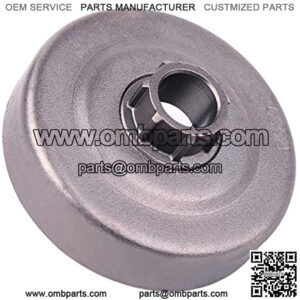How to Fix Stuck Snowmobile Clutch
If the primary clutch of your snowmobile is stuck, you can either pull it out using the standard clutch puller or you can use fluid to create a high pressure that will pop out the clutch. Both methods require a good strategy. Let us first talk about the method that doesn’t require a clutch puller.
If you do not have a clutch puller, you should follow these steps to remove your snowmobile’s clutch.
- Before you attempt to remove the clutch, you should remove the battery from your snowmobile so it doesn’t spill while you roll the snowmobile on its side.
- Also, you need to switch off the engine and remove the spark plug because the snowmobile can start by merely rotating the clutch.
- It would help if someone else is around to assist you with a few things.
If you have done the things above, you can proceed with these steps.
- Lift the snowmobile off the ground and allow it to rest on its side.
- Be careful not to damage the snowmobile while placing it on its side.
- Locate the clutch and get ready to remove the bolt at the center of the primary clutch.
- Ask someone to hold the primary clutch so that it won’t spin while you are removing the bolt at its center.
Get a bucket of water ready because you are about to use it to build pressure inside the void where you removed the bolt. To build this pressure, you should pour water into the hole at the center of the primary clutch. When the water starts to overflow, you should return the bolt back to the hole and tighten it.
Since water can’t compress, the pressure inside the hole will begin to increase as you tighten the bolt. When the pressure gets high enough, it will pop the clutch off.
Ensure you wear safety google and don’t stay directly above the work area to avoid getting an impact from the clutch when it pops off.
If you have a clutch puller, then you can choose to remove the clutch using the steps that follow.
- Start by removing the bolt at the center of the primary clutch just like we mentioned in the first method.
- Pour a little quantity of grease around the threads of the clutch puller.
- After that, you should hold the clutch while you screw the clutch puller into its center.
- As the clutch puller goes deeper into the hole, it will be pushing up against the crank.
When it exerts enough force on the crank, the clutch will pop off. Once the clutch is free, you need to clean the grease inside the hole before you return the clutch to its place.
Please note that different snowmobiles require different Clutch Pullers (link to Amazon), so you must get the one that suits your snowmobile.
How to Fix Snowmobile Clutch That Won’t Engage
You should check the following if your snowmobile’s clutch fails to engage:
Check the belt deflection
If the belt is too slack, the clutch may not engage at all or it may engage inadequately. You can easily check whether the belt is saggy by observing its extension below the snowmobile.
You can push it down with a little force and see if it is slack. If it is slack, you can set it to have a proper deflection by adjusting the locknut on the secondary clutch.
- To adjust a saggy belt on the secondary clutch, you need to raise the snowmobile off the ground and let it rest on a support.
- After that, you should tighten the locknut on the secondary clutch.
- Attempt to engage the clutch while the snowmobile is off the ground and observe whether the track can now spin.
Check clutch alignment
If the clutch isn’t aligned, it won’t engage. Also, a misalignment in the clutch will cause the belt to bind and wear out quickly. To check whether the clutch is misaligned, you should open up the clutch and watch out for warped flywheel, warped friction disc, and distorted clutch linkage.
If the flywheel and friction disc are warped, you have to replace them. However, if the issue with the clutch is distorted linkage, you can correct the issue using a clutch alignment tool.
To align the clutch, you should get a Clutch Alignment Tool (link to Amazon) that matches your clutch. Thereafter, you should use the tool to align the disc perfectly at the center of the flywheel.
Check for wear and tear
If the clutch wears beyond the range of tolerance, it won’t engage. Various parts of the clutch are subjected to heat and friction, which makes them wear out. As the clutch wears unevenly, it will eventually become unbalanced, making it hard for the clutch to engage.
You can easily spot wear and tear when you inspect the clutch. You should replace the clutch if you see things such as cracks, bends, or any other deformation.
This will not only assist you in restoring the full performance of your clutch, but it will also save you from accident that may result from clutch explosion.
Adjust the belt-to-sheave clearance
The gap between the movable sheave of the primary clutch and the belt plays an important role in clutch engagement. An ideal sheave clearance is between .010” to .015”. You can easily measure the sheave clearance for your snowmobile so that you will know whether you should adjust it.
The manufacturers of snowmobile always set the belt-to-sheave gap properly, but due to wears in the belt, this gap increases, making it difficult for the clutch to grab the belt for engagement.
Once you’ve measured the gap and it’s outside the range of .010” to .015”, then you need to adjust it before your clutch can engage.
Check friction surfaces
The clutch needs friction to work efficiently. Oil can contaminate the friction disc and other parts of the clutch, and thereby reduce the friction along their surfaces.
- Oil contamination is easy to detect once you open up the clutch.
- If you notice oil contamination along surfaces of the clutch, you should wipe it off with a dry cloth.
- Aside from cleaning oil, you need to watch out for belt residue along the sheaves and belt.
Belt residues can also reduce friction, so it is important to remove them. You should also remove gaze from the belt if you can see traces of it. Once the clutch surfaces and the belt have enough friction, the clutch will engage successfully.

